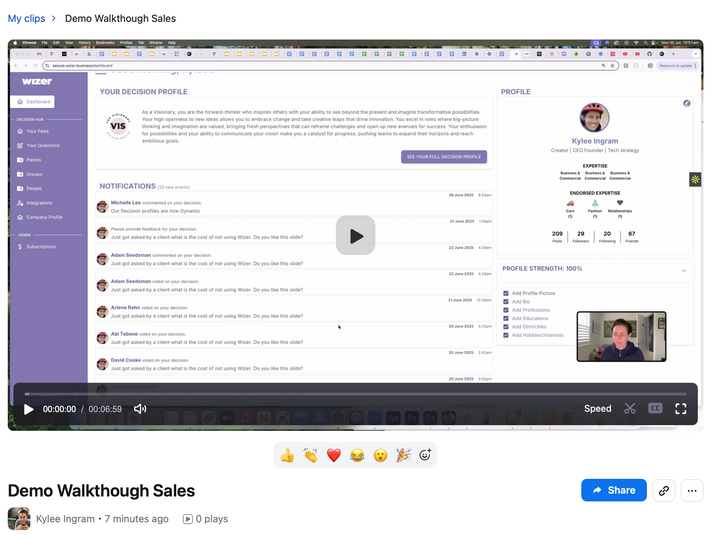
Demo
A great demo isn’t just showing the platform — it’s helping the client see themselves using it.
CEO Kylee will do this Demo with clients until you are ready to do.
Key Demo Principles:
-
The platform itself is simple — but the magic is in how you frame it.
-
Make it relevant: change the names of the groups or decision panels to reflect the client’s world.
-
Come prepared with a really good question that fits their context.
Demo Setup Checklist:
-
Log in before the meeting. Make sure you’re comfortable moving through the platform.
-
Change the group names to match the client.
→ Example: Change “Leadership Team” to “ABC Corp Strategy Group” or “DEI Steering Group.”
→ ⚠️ Do not create new groups for the demo — or you’ll lose your data. Just rename existing ones.
-
Have a decision question ready to drop into the system.
-
Make it relevant to their work — strategy, stakeholder engagement, inclusion, transformation.
-
Examples:
-
“What is the most important thing we need to achieve in our next strategic cycle?”
-
“Which stakeholders should be prioritized in our next project?”
-
“What’s the biggest opportunity to improve employee experience?”
-
-
What Clients Love to See in a Wizer Demo:
1. Their Individual Decision Profile
-
This is always a highlight.
-
People are curious about how they think, how they contribute to decisions, and where their blind spots are.
-
It instantly makes the demo personal and meaningful.
2. How Easy It Is to Add People and Create Groups
-
Show how simple it is to build a decision group — internal teams, external stakeholders, or mixed panels.
-
Clients are often surprised by how quick this is compared to traditional stakeholder management.
-
Pro tip: Rename groups to match their world (“ABC Project Team”, “Sustainability Working Group”, etc.).
3. The Aggregated Data View
-
Show how individual profiles roll up into group profiles.
-
Clients love seeing:
-
How balanced (or unbalanced) their group is.
-
What thinking styles are dominant or missing.
-
How this data can inform decisions beyond the immediate project — it becomes part of their organizational intelligence.
4. The Live Decision Process
-
Take them through a sample decision workflow:
-
How to frame a question.
-
How it gets pushed to the right people.
-
Show them a decision answer and click on the different categories for those answers
5. Spend the Most Time on the Recommendation Page
-
This is where the demo clicks:
-
Show the Panel Strength Meter.
-
Point out when it’s low — highlight what’s missing (e.g., “This group is heavy on strategic thinkers but light on delivery or risk perspectives.”)
-
Walk them through the Recommendation Engine:
-
How the system suggests the right people to improve the decision strength.
-
Add those missing profiles live and show how the panel strength improves in real time.
-
Clients love seeing how blind spots are made visible — and fixable.
-
🏁 Final Tip:
-
“Don’t try to show everything. The moment of magic is when they realize: ‘Ah — this shows me who’s missing from my decision.’ That’s when the demo lands.”
